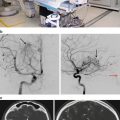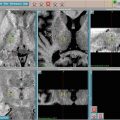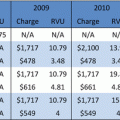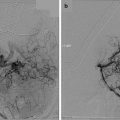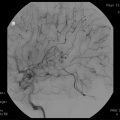Mechanism of action
Toxicity
Carmustine (BCNU)
Chlorethylating agent
Myelosuppression
Nausea/vomiting
Pulmonary fibrosis
Lomustine (CCNU)
Chlorethylating agent
Myelosuppression
Nausea/vomiting
(Pulmonary fibrosis)
Nimustine (ACNU)
Chlorethylating agent
Myelosuppression
Nausea/vomiting
Thrombocytopenia
Fotemustine
Chlorethylating agent
Nausea/vomiting
Temozolomide
Methylating agent
Thrombocytopenia
Nausea/vomiting
Irinotecan (investigational)
Topoisomerase 1 inhibitor
Diarrhea
Nausea/vomiting
Neutropenia
Bevacizumab
Anti-VEGF monoclonal antibody
Hypersensitivity reactions
Hypertension, Proteinuria
Hemorrhage
Nitrosoureas
Nitrosoureas were the principal drugs for malignant glioma for over 20 years. These lipophilic alkylating agents readily cross the blood–brain barrier and have shown some activity in patients with recurrent malignant glioma. Efficacy of lomustine [CCNU] has recently been confirmed in prospective randomized trials where lomustine served as the control arm [26, 27].
Carmustine
Carmustine (BCNU) has been the most widely used chemotherapy for malignant glioma. In recent years, lomustine (CCNU) or nimustine (ACNU; 1-[(4-amino-2-methyl-5-pyrimidinyl)methyl]-1-(2-chloroethyl)-3-nitrosourea) have, in part, replaced BCNU, to lessen pulmonary toxicity. Fotemustine is a second-generation nitrosourea that has single-agent activity against recurrent glioma [28]. In Japan and Germany, nimustine (ACNU) is preferred, and fotemustine is most popular in France and Italy [28–32]. Other toxicities include moderate and controllable nausea/vomiting, and unpredictable and late myelosuppression (in particular in patients who had previously received other chemotherapy).
Lomustine
Lomustine (CCNU) is an orally available nitrosourea and is part of the PCV combination regimen. In recent years single agent lomustine was used as the control arm in randomized trials investigating novel agents. While those trials failed to demonstrate superiority of the investigational drug, it confirmed in contemporary trials the efficacy of lomustine in recurrent glioblastoma after first line chemoradiotherapy [26, 27]. Response rates were low (4–9 %) with a PFS6 of 19–25 %, comparable to what had previously been reported for temozolomide in this setting.
Procarbazine
Procarbazine is an alkylating agent that is given orally but requires hepatic activation. In a randomized trial comparing procarbazine vs. BCNU vs. BCNU and methylprednisolone vs. methylprednisolone alone, the chemotherapy arms were equivalent and slightly superior to methylprednisolone alone [33]. Median survival was only 9–12 months from diagnosis. In the setting of recurrent malignant glioma, response and tumor control rates of 30 % have been reported [34, 35].
The PCV Regimen
In the 1970s, investigators from University of California San Francisco (UCSF) developed the PCV regimen, a combination of procarbazine, lomustine (CCNU), and vincristine. In 1990, Levin et al. reported that adjuvant chemotherapy with procarbazine, CCNU, and vincristine (PCV) yielded better survival results than adjuvant BCNU for newly diagnosed malignant glioma. This assertion was based on a reanalysis of a randomized trial conducted between 1977 and 1983 [36]. The survival difference favoring PCV was only statistically significant for the subgroup of patients (n = 73) with anaplastic astrocytomas (total patients randomized, 148) and good performance status, who had received at least 1 cycle of chemotherapy [36]. The superiority of PCV could not be confirmed in a subsequent pooled analysis of 432 patients treated on Radiation Therapy Oncology Group (RTOG) protocols [37]. The Medical Research Council (UK) conducted a randomized trial of standard focal radiotherapy (RT) vs. RT plus adjuvant PCV chemotherapy [38], finding no difference in overall survival. Patients with grade 3 tumors also did not benefit from PCV.
Temozolomide
Over the past decade, temozolomide (TMZ) has emerged as an active agent against malignant glioma [39]. TMZ is an oral alkylating agent, which is rapidly and completely absorbed and spontaneously converts at physiological pH to the active metabolite, MTIC. TMZ has linear pharmacokinetics with maximum plasma concentrations 30–90 min after oral intake. Although recommended to be taken in a fasting state (at least 1 h before and after intake), food will only lead to a 10 % reduced area under the concentration curve (AUC) and a delayed peak concentration [40]. TMZ has an excellent penetration into all body tissues. Pharmacokinetics of TMZ in the CSF have been reported. The AUC in the CSF as a surrogate for brain tissue penetration corresponded with approximately 20 % of the area under the curve (AUC) in plasma [41]. Similar to nitrosoureas, TMZ is a DNA alkylating agent. Methylation of the O-6 position of guanine by TMZ is an especially important biological action, although not the most frequent adduct. If left unrepaired, the guanine O-6 lesion triggers cytotoxic responses and apoptosis.
Three pivotal phase II trials led to the approval of temozolomide (Temodar; Temodal; Schering-Plough, Kenilworth, NJ, now MSD/Merck & Co, Whitehouse Station, NJ). The U.S. FDA granted provisional (accelerated) FDA approval in 1999 for the treatment of recurrent anaplastic astrocytoma. In Europe, it was also approved for the treatment of recurrent glioblastoma [42–44]. Although the objective response rate in the glioblastoma trials was low (5 % and 7 %, respectively) and was only 35 % in the anaplastic astrocytoma studies, each trial suggested an increase in the fraction of patients being progression-free at 6 months compared with a historical database [24]. This observation encouraged further evaluation of TMZ as a therapy for both recurrent and newly diagnosed malignant glioma. For recurrent glioma, a randomized phase III trial of TMZ vs. PCV in previously irradiated, chemonaive patients has been conducted by the British National Cancer Research Institute. In a second randomization this trial also compared two different TMZ administration schedules (standard 5-day regimen vs. dose-dense 3 weeks out of 4). In this trial TMZ efficacy was equivalent to PCV with less toxicity, however dose intensification did not demonstrate an improved outcome, numerically the standard regimen was slightly superior [45]. Similarly, a German randomized NOA-04 trial also compared the standard to a dose-intensified TMZ regimen and could not show a benefit for the alternative dosing schedule [46]. Intensification of the TMZ regimen failed to demonstrate improved outcome in a large randomized trial in newly diagnosed GBM patients (RTOG0525/Intergroup trial, discussed below) [47].
The definitive role of TMZ in the initial treatment of newly diagnosed glioblastoma was demonstrated in a randomized phase III trial by the European Organisation for Research and Treatment of Cancer (EORTC) and the NCI Canada Clinical Trials Group [48, 49]. This landmark trial established the role of early use of chemotherapy in the management of glioma, and led to definitive regulatory approval of TMZ both in the United States, and worldwide. Further details are discussed in the next main paragraph.
Bevacizumab and Anti-angiogenic Therapy
Unprecedented rapid disappearance of contrast enhancement, reduction in peritumoral edema, and temporary clinical improvement have been observed with the anti-VEGF (vascular endothelial growth factor) monoclonal antibody, bevacizumab and the VEGF receptor tyrosine kinase inhibitor cediranib [54, 55]. The neutralizing antibody bevacizumab will abrogate the vascular endothelial growth factor A (VEGF)-mediated inflammation and restore the blood brain barrier. This leads to less peritumoral edema and reduces gadolinium-diffusion into the brain. Consequently, radiological tumor extension appears to be lesser, and steroids can be reduced or completely discontinued. This led to enthusiastic large-scale use and investigation of anti-angiogenic and vasculature-modifying agents in malignant glioma. For cediranib, a randomized phase III trial compared single agent cediranib vs. the combination of cediranib and lomustine vs. lomustine alone. Although progression-free survival favored the two experimental arms, no significant difference in survival could by demonstrated with the addition of cediranib [27]. Actually, patients receiving lomustine fared best with a median overall survival of 9.8 months (compared to 8.0 and 9.4 months in the cediranib alone or in combination with lomustine arms, respectively, p = NS). In the United States bevacizumab received regulatory approval for recurrent glioblastoma, based on two uncontrolled phase II trials demonstrating a high radiological response rate, a decrease in steroid requirements and median survival of around 9 months [54, 55]. The European Medicines Agency rejected the application in the absence of controlled data [56].
Two independent phase III randomized trials have been initiated by the RTOG (trial#0825) and by Roche (AvaGlio) in newly diagnosed GBM patients. Bevacizumab is added to standard chemoradiotherapy (TMZ/RT → TMZ, see below) first line treatment. Both trials failed to demonstrate improvement in overall survival, as expected radiological progression-free survival was prolonged [57, 58]. Intuitively it appears that prolongation in progression-free survival and a decrease in steroid requirements would translate into improved quality of life. However, the detailed analysis of net clinical benefits in the Radiation Therapy Oncology Group (RTOG)-sponsored study suggested the contrary, while quality of life assessments in the Roche-sponsored AvaGlio study stopped at the time of radiological tumor progression, and does not allow for definitive conclusions. Furthermore, toxicity and serious adverse events (hypertension, thromboembolic complications, wound dehiscence and hemorrhage) were all more prevalent in the bevacizumab-treated patients.
Miscellaneous Agents
Various other agents have been investigated and are occasionally used in the treatment of recurrent glioma. Randomized trials failed to demonstrate any relevant and reproducible antitumor activity of the tyrosine kinase inhibitors imatinib and erlotinib when used as single agents [51, 62]. Irinotecan is occasionally used as single agent [63, 64] or in combination with bevacizumab [54], some activity has been reported for cis- and carboplatin [65–67].
Primary Treatment of Glioblastoma
The value of radiotherapy in the treatment of malignant glioma (both glioblastoma and anaplastic astrocytoma) was established in randomized trials almost 30 years ago [68–71]. Compared with supportive care or nitrosourea-based chemotherapy alone, radiotherapy increased median survival from 4 to 8 months. Subgroup analyses suggested that the addition of chemotherapy to RT might further improve survival for patients with grade 3 and 4 tumors, but none of the randomized trials demonstrated an unequivocal beneficial role for nitrosourea-based chemotherapy. A meta-analysis based on published studies, and in the year 2002 [72] and in the year 2002, an analysis of pooled individual data from more than 3,000 patients in 12 randomized trials [73] found a small but significant survival advantage, favoring chemotherapy in addition to surgery and RT at initial diagnosis. For patients with both grade 3 and 4 tumors, a hazard ratio of 0.85 for chemotherapy equated to a 5 % improvement in overall survival from 15 to 20 % at 2 years [73].
In a German multicenter trial with patient accrual from 1994 to 1999 BCNU was replaced by nimustine (ACNU), another nitrosourea with less pulmonary toxicity [32]. Three hundred seventy-five patients were randomized to radiotherapy and either ACNU/cytarabine or ACNU/teniposide; unfortunately there was no radiotherapy-alone control arm. No difference in survival between the two chemotherapy regimens could be shown; nevertheless the survival outcomes were encouraging with a median survival of 16 months and a 2-year survival rate of 27 % among 302 patients with glioblastoma. More than 90 % of patients had undergone debulking surgery, and accrual occurred over 6 years in 15 centers (average of three patients per year per center). Thus, a strong selection bias cannot be excluded.
In 2005, the EORTC and NCIC (National Cancer Institute of Canada Clinical Trials Group) Intergroup trial demonstrated beyond doubt that chemotherapy (i.e., TMZ during RT and for 6 months afterward {TMZ/RT → TMZ}) improved overall survival in patients with glioblastoma [48]. In this phase III trial, 573 patients were randomized in less than 18 months. Patients who received initial treatment with RT alone (but may have received TMZ or other chemotherapy at progression) had a median survival of 12 months compared with 15 months for patients treated with TMZ/RT at diagnosis. More importantly, the chances of survival at 2 years were only 11 % in the RT arm compared with 27 % for those treated with TMZ/RT [49]. This trial established the current standard of care for patients with glioblastoma and serves as the benchmark to which newer strategies must be compared (Fig. 19.1). These results compare favorably with reported results among patients with small tumors eligible for stereotactic radiosurgery. The good outcome in the control arm also reflects the, albeit modest, activity of the TMZ when administered as second-line therapy after tumor progression.
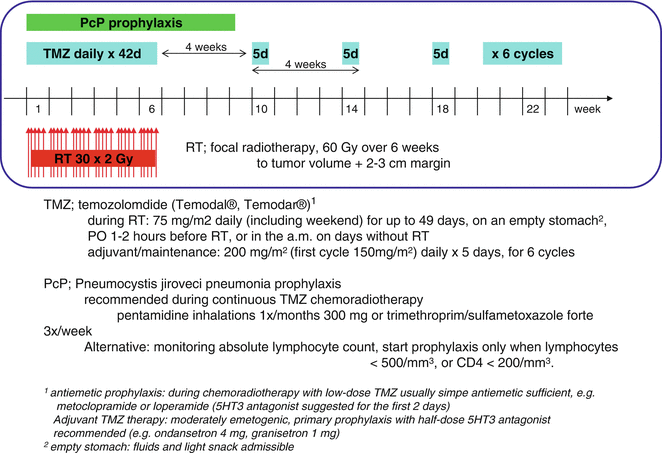

Fig. 19.1
Treatment scheme for newly diagnosed glioblastoma. From: Mino, Homicsko & Stupp: central nervous system In: M.A. Dicato (ed.), Side effects of medical cancer therapy, Springer London 2013, doi:10.1007/978-0-85729-787-7_7; used with permission
Methylguanine Methyltransferase
Methylguanine methyltransferase (MGMT) gene promoter methylation has been established as the single most important predictive and prognostic marker in malignant glioma [74, 75]. Patients whose tumors have a methylated MGMT gene promoter, resulting in gene silencing, decreased expression of MGMT, and less effective repair of DNA damage caused by TMZ are benefitting most from the addition of chemotherapy [76]. This predictive value has been repeatedly confirmed in glioblastoma patients, while in patients with anaplastic glioma, MGMT is a strong favorable prognostic factor independent of treatment, but loses in predictive strength [46]. In the pivotal EORTC/NCIC trial glioblastoma patients with tumors in which the MGMT gene promoter was unmethylated and thus presumably fully expressed MGMT, no apparent benefit was derived from the addition of TMZ during and after radiotherapy [76]. Patients with an unmethylated tumor treated with TMZ/RT had a median survival 13 months (2-year survival rate of 14 %), compared to 12 months (2-year survival rate 2 %) when treated initially with RT alone (at recurrence the great majority of patients received chemotherapy) [76]. In patients with an MGMT methylated tumor, median survival was 22 months (2-year survival 46 %) when treated with TMZ/RT → TMZ, compared to 15 months (2-year survival: 23 %) if received RT alone at initial diagnosis (Fig. 19.2).
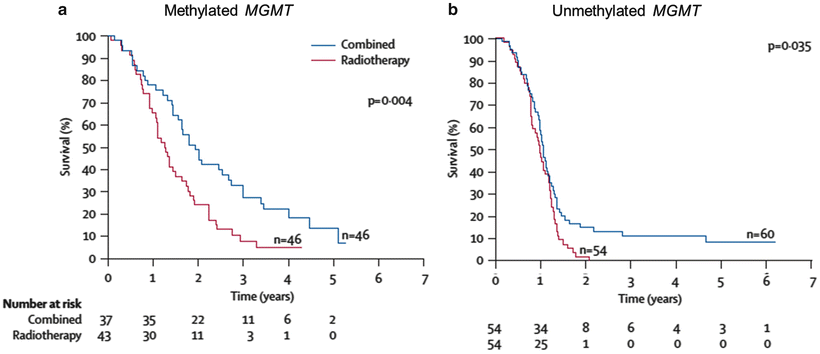

Fig. 19.2
Survival according to MGMT status and treatment allocation (combined modality vs. RT alone). Left panel: survival of patients with a methylated MGMT promoter if treated with TMZ/RT → TMZ (blue) or initial RT only (red). Right panel: survival if MGMT unmethylated according to randomized treatment allocation. Reprinted with permission from Stupp R, Mason WP, van den Bent MJ et al. Radiotherapy plus concomitant and adjuvant temozolomide for glioblastoma. N Engl J Med 2005; 352: 987–996; used with permission
The RTOG0525/EORTC/NCCTG (North Central Cancer Treatment Group) Intergroup trial aimed at overcoming the MGMT-mediated resistance by dose intensification and exhaustion of MGMT by continuous chemotherapy exposure. Almost 1,200 patients were included and 833 patients were randomized after determination of and stratification for MGMT status. The prognostic value of MGMT promoter methylation status was confirmed with a median survival of 21.2 months for methylated tumors, compared to 14 months for the unmethylated group [47]. However, neither treatment intensification nor prolongation of the maintenance chemotherapy for up to 12 cycles appeared to improve outcome, overall median survival was 16 months from registration (approx. 2–6 weeks after surgery). Ongoing investigations are either stratifying patients according to the MGMT status, or devising separate treatment strategies for patients with and without MGMT promoter methylation (see Elderly below).
Treatment of Anaplastic Glioma
Table 19.2 shows selected treatment options and potential alternatives for anaplastic glioma.
Table 19.2
Selected treatment options and potential alternatives
Treatment | Evidence level | References | Alternatives | Evidence level | References | Remarks |
|---|---|---|---|---|---|---|
Glioblastoma | ||||||
TMZ/RT → TMZ × 6 for elderly patients | I | [48] | ACNU/RT → ACNU + VM26 | III | [21] | |
Methylated MGMT: TMZ | II | Hypofractionated RT | II | For elderly patients | ||
Unmethylated MGMT: RT | ||||||
Anaplastic astrocytoma RT | I | BCNU/RT → BCNU | II | [33] | ||
TMZ/RT → TMZ | V | [50] | Analogy to GBM | |||
Anaplastic grade III oligoastro/oligodendroglioma with LOH 1p/19a | ||||||
RT → PCV x 6 | II | PCV × 4 before RT | II | Improved survival | ||
RT → TMZ | V | Replace PCV by TMZ | ||||
or | ||||||
TMZ → RT | ||||||
TMZ/RT → TMZ | V | [50] | Analogy to GBM | |||
Recurrent glioma | ||||||
TMZ | II | Procarbazine | IV | [46] | ||
PCV | IV | [81] | ||||
Bevacizumab | III | Irinotecan* | IV | |||
Anaplastic Astrocytoma
Unlike glioblastoma, there are no randomized data providing level I evidence on the role of chemotherapy in the initial treatment of anaplastic astrocytoma. Some trials, however, have suggested a benefit from adjuvant nitrosourea-based therapy for patients with grade III tumors [70, 77].
One of the few positive trials was reported by the EORTC. Two hundred sixty-nine patients with malignant glioma were randomized to focal RT vs. RT + dibromodulcitol and BCNU [77]. The longer survival in the experimental arm was mainly due to the subgroup of 29 (!) patients with non-glioblastoma high-grade tumors. A confirmatory randomized EORTC trial in grade III tumors failed to demonstrate a statistically significant improvement in outcome [78]. A randomized trial comparing adjuvant PCV with adjuvant PCV plus difluoromethyl ornithine (DFMO), an ornithine decarboxylase inhibitor, has been reported [79]. Patients were randomized at the end of RT. Those who had already progressed or had declining performance status were not included in the study. Patients with grade 3 gliomas experienced longer statistically nonsignificant survival and time to progression in the PCV + DFMO arm [79]. An identical trial in patients with glioblastoma was negative [79].
In one phase II trial, in patients with recurrent anaplastic astrocytoma, TMZ has shown a high objective response rate of 35 %. A randomized trial (RTOG9813) comparing radiotherapy plus adjuvant BCNU or CCNU vs. adjuvant TMZ in newly diagnosed patients was closed early due to insufficient accrual.
The German NOA-04 trial compared two treatment strategies: patients with anaplastic glioma were randomized to either RT alone, and chemotherapy at recurrence vs. the opposite sequence with a primary endpoint of time to the second failure. The data suggest that it does not matter which strategy is employed first. MGMT promoter methylation was again a strong prognostic marker, however it was not predictive for benefit from chemotherapy when analyzed by time to first progression [46].
Anaplastic Oligoastrocytoma and Oligodendroglioma
Since the year 2000 WHO criteria and greater awareness of this subgroup, oligoastrocytoma and oligodendroglioma are increasingly identified as separate and distinct tumor entities [80]. While mixed oligoastrocytomas behave largely like astrocytomas, pure oligodendrogliomas have a more favorable natural history. Specific molecular changes, in particular the loss of genetic information on chromosomes 1p and 19q, have been associated with high sensitivity to chemotherapy and with particularly long survival [81]. Two randomized trials investigated neoadjuvant (before RT) or adjuvant (after completion of RT) PCV chemotherapy in patients with newly diagnosed anaplastic oligoastrocytomas and oligodendrogliomas [82, 83]. Both trials confirmed a more favorable prognosis for patients with loss of heterozygosity (LOH) of 1p/19q. While at initial analysis after a median follow-up of more than 6 years, no benefit in overall survival was detected [82, 83], a subsequent analysis, performed in 2012 after a median follow-up of 11 years, found a significant survival benefit for patients with oligodendroglioma harboring a co-deletion of chromosomes 1p and 19q [84, 85]. These findings are supported by the earlier observation of prolonged progression-free survival in this genetically defined subset, suggesting that prolongation of progression-free survival may be a meaningful surrogate endpoint. These trials also emphasize that the subgroup of patients with 1p/19q co-deletion represent a distinct pathologic entity and future revisions of the WHO classification may include molecular characterization as a mandatory condition of pathological categorization.
How to Select Patients for Chemotherapy?
When considering patients with malignant glioma for a specific therapy, treatment-related, tumor-related, and patient-related factors need to be considered. One of the most important deterrents to chemotherapy is poor performance status. Patients with poor neurologic function are unlikely to improve substantially with chemotherapy. Similarly, patients with poor general functioning are unlikely to tolerate chemotherapy sufficiently well to achieve a benefit, especially when the response of malignant gliomas is often slow or protracted.
Tumor size and resectability are prognostic factors [86]. For large, deep tumors and tumors crossing the midline, only biopsy with stereotactic guidance is suggested. Tumors in these locations are often accompanied by rapidly progressive neurologic symptoms, steroid dependence, and deteriorating performance status. In all clinical trials, these types of patients have very poor outcomes irrespective of treatment with TMZ/RT or other treatment measures. In the EORTC/NCIC trial, a trend for longer survival after TMZ/RT could also be demonstrated among patients with a tumor biopsy only (median survival 9.4 vs. 7.4 months, p = 0.09) (see supplementary appendix to [48] at http://content.nejm.org/cgi/content/full/352/10/987/DC1).
In our clinical practice, we aim at providing all care in the outpatient clinic both with chemotherapy and radiotherapy. For patients with severely impaired performance status, we frequently recommend single-modality therapy or supportive care only. Nevertheless, French investigators reported on a phase II trial including elderly patients (median age 77 years, range 70–87) with a Karnofsky performance status below 70. Seventy patients were treated with single agent TMZ (5/28 days). One third of the patients improved their performance status to ≥70 % and regained some independence and quality of life [87]. The median survival was 5.8 months, while subgroup analyses of patients with methylated or unmethylated MGMT showed median survivals of 7.2 and 4.4 months, respectively.
Treatment of the Elderly
Although the median age of glioblastoma patients in clinical trials ranges from 52 to 57 years, the median age in daily practice is 62–65 years. Glioblastoma is a disease of the elderly. The age at diagnosis has been repeatedly shown to be an important prognostic factor for survival. Based on poor outcomes for patients over the age of 60 or 70 years, it had been suggested that these patients should only be managed with supportive care. However, contemporary randomized trials have revisited this attitude. A French trial compared radiotherapy (28 × 1.8 Gy, 50.4 Gy) with best supportive care in 84 patients over the age of 70 years (median, 73 years, range 70–85 years). Overall survival in patients receiving radiotherapy was 6.8 months compared with 4 months with best supportive care only (p = 0.002) [88]. Roa et al. reported equivalent survival when treating glioblastoma patients over the age of 60 years (mean 72 years) with either standard fractionated radiotherapy (30 × 2 Gy, 60 Gy in 6 weeks) or with hypofractionated radiotherapy (15 × 2.66 Gy, 40 Gy in 3 weeks) [89]. Median survival durations were 5.1 and 5.6 months, respectively (p = 0.57). In the EORTC/NCIC TMZ/RT → TMZ trial, patients over the age of 50 years had inferior overall survival, but the benefit afforded by TMZ/RT was maintained across all age groups, including patients > 60 or 65 years (patients >70 years were not eligible for trial participation) [49]. Therefore, combined treatment should not be withheld based on age alone.
Two randomized trials compared exclusive radiotherapy with chemotherapy alone [90, 91]. In the 3-arm Nordic trial 342 patients (median age of 70 years, range 60–88) were randomly assigned to one of two RT (10 × 3.4 Gy or 30 × 2 Gy) schedules or standard dose TMZ monotherapy [90]. The study showed that standard fractionated RT was particularly poorly tolerated in patients older than 70 years, and that single agent TMZ may be a valid alternative to radiotherapy. Median overall survival was 6.0 months with RT60 (30 × 2 Gy), 7.5 months with RT34 (10 × 3.4 Gy), and 8.3 months with TMZ (5/28 days) [90]. The German NOA-08 trial compared standard fractionated RT (30 × 2 Gy) with 1 week on, 1 week off, dose-dense TMZ in 373 elderly patients (median age 72 years, range 66–84) [91]. Overall survival analysis favored RT (median 9.6 vs. 8.6 months, p = 0.033), however exclusive radiotherapy appears to be detrimental for patients with a methylated MGMT. Taken together elderly patients with methylated MGMT tumors are best treated with TMZ chemotherapy, while unmethylated fare better when treated with RT alone [91].
An ongoing trial coordinated by the NCIC in collaboration with the EORTC is evaluating combined modality hypofractionated TMZ/RT → TMZ vs. RT (15 × 3 Gy) alone in patients over the age of 65 years but unfortunately, this trial lacks a chemotherapy alone arm.
RPA Analysis
Grouping of the patients according to the RTOG recursive partitioning analysis based on age, performance status, neurologic function, treatment, and tumor grade allows for some comparison between trials and variable distribution of prognostic factors [92–94]. Table 19.3 shows recursive partitioning analysis of the EORTC/NCIC trial.
Table 19.3




Recursive partitioning analysis of the EORTC/NCIC trial
Stay updated, free articles. Join our Telegram channel

Full access? Get Clinical Tree



